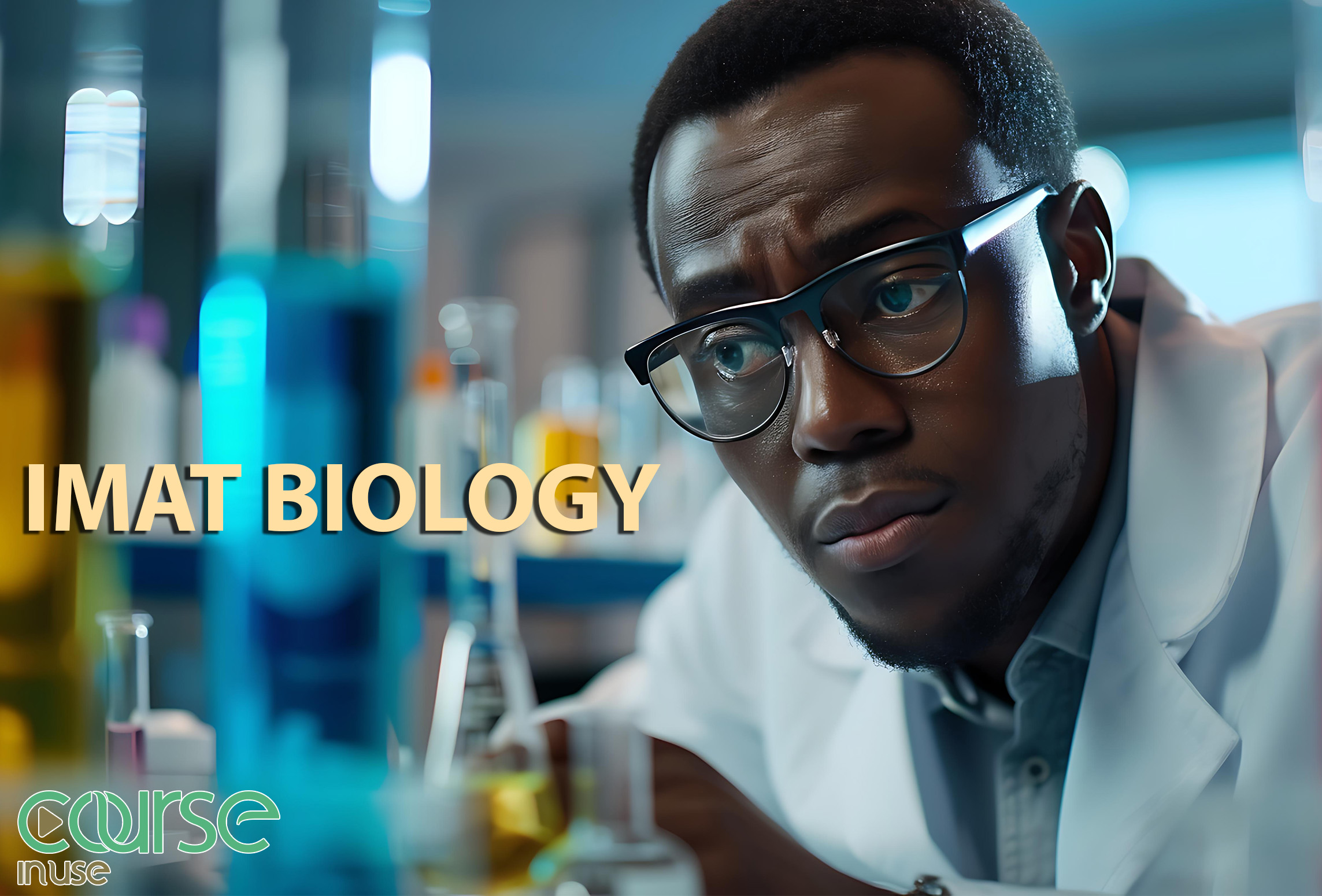The biology course plays a very important role in the IMAT test, which significantly includes the largest number of questions, so if you are a candidate applying for the IMAT exam, you should know what topics you should focus on. We will review the most important biology topics for the IMAT exam, the biology questions of the IMAT exam, as well as the current strategy for success in the IMAT exam and IMAT test preparation tips.
If you want to know the structure and format of IMAT biology exam. Know how to deal with each section and increase your chances of success. Stay with us until the end of this article.
The IMAT Exam and the Importance of Biology
The IMAT exam (International Medical Admissions Test) is a standardized test used for admission to medical and dental programs in Italy. Biology is a crucial component of this exam, as students pursuing these fields need a deep understanding of the subject. To succeed in the IMAT, it is essential to have a solid grasp of biological concepts and engage in consistent practice.
IMAT test syllabus
The IMAT exam is conducted in English, and for this purpose, as an applicant for the IMAT exam, you need to have an IELTS language certificate. Accepting IMAT allows candidates to benefit from lower tuition fees at prestigious Italian universities, receive scholarships, and study medicine and dentistry in English. The IMAT test is a 100-minute test that includes 60 four-choice questions, which are questions in the fields of biology, Chemistry, mathematics, physics, and logic. The total score for IMAT is 90 points. This test also includes negative marking: 0.4 points are deducted for each incorrect answer and 1.5 points are awarded for each correct answer.
IMAT Biology Topics
IMAT Biology covers a wide range of biology topics. The topics examined in the IMAT exam are the same topics that high school students are familiar with, because many of the basic concepts taught in high school are covered. Back Next, we will review the main topics covered in the biology section of the IMAT exam
The biology section of the IMAT covers the following topics:
- Cell Biology:
- Structure and function of prokaryotic and eukaryotic cells
- Cell division (mitosis and meiosis)
- Cell membrane and transport mechanisms
- Genetics and Biotechnology:
- Structure and function of DNA and RNA
- Protein synthesis
- Mendelian inheritance
- Genetic engineering and biotechnology
- Human Anatomy and Physiology:
- Body systems (digestive, circulatory, respiratory, nervous, and immune)
- Function of organs and tissues
- Microbiology and Immunology:
- Structure and function of bacteria, viruses, and other microorganisms
- Immune system
- Ecology and Evolution:
- Principles of ecology
- Evolutionary theories
- Environment and biodiversity conservation
IMAT 2026 Biology Topic List
1.Chemistry of living organisms
2.Types of Biological Bonds and the Biological Importance of Weak Bonds
3.The role of organic molecules in living organisms
4.Cell Biology
5.cell membrane
6.Cell cycle and cell reproduction
7.Reproduction and heredity
8.Mendelian genetics
9.Classical genetics
10.Molecular genetics
11.Human genetics
12.Evolutionary theories
13.Genetic basis of evolution
14.Heredity and environment
15.Biotechnologies
16.Anatomy and physiology
17.Cellular Energy Metabolism
What Are IMAT Biology Questions Like?
The design of IMAT biology questions is such that in addition to measuring your scientific knowledge, your skills in analyzing and applying the principles of biology are also evaluated.
1.Conceptual questions
Conceptual questions assess your understanding of basic biology concepts such as biological processes or the role of enzymes that require deep understanding.
2.Practical questions
Practical questions are more challenging, and in other words, you need to use your biological information to answer these questions. From this sample of questions, you can refer to the question related to the recognition of hereditary patterns.
3.Data interpretation questions
In this part, you should have a proper analysis and interpretation of the biological data that is given to you in the form of a table or graph.
4.Experiment design questions
Design of Experiment questions simply examine our scientific methodology, such as designing an experiment.
5.Terms and definitions
In the IMAT exam, you need to be fully familiar with biology terms, because questions about definitions and terms may be asked in the IMAT exam.
Budgeting biology questions of the IMAT exam
Budgeting biology questions of the IMAT exam 2011
| topic | Number of questions | Headlines |
| Cell Biology | 2 | Characteristics of eukaryotic and prokaryotic cells
cell division mitosis and meiosis |
| Genetics | 6 | DNA structure and function
Hereditary patterns crossing over Protein translation Genetic codes |
| Physiology | 5 | Cell Function
Physiology of nerves Respiratory Physiology Metabolism of sugars The role of hormones |
| biochemistry | 4 | Features of water
Glycolysis process Energy metabolism and ATP production Structure and function of polysaccharides |
| Evolution | 1 | Natural selection |
| Human Anatomy | 0 | – |
| Microbiology | 0 | – |
| Immunology | 0 | – |
| Ecology | 0 | – |
- In the 2011 IMAT exam, the biology section of the IMAT exam included 18 questions.
Budgeting biology questions of the IMAT exam 2012
| topic | Number of questions | Headlines |
| Cell Biology | 1 | Membrane structure and function |
| Genetics | 6 | Gene expression
Inheritance The structure and characteristics of chromosomes Structure of DNA and RNA The genetic difference between twins |
| Physiology | 5 | Function of hormones
Endocrine glands Neurophysiology Homeostasis Metabolic processes and substance exchange inside the body |
| biochemistry | 5 | Protein production
Physical and chemical properties of water The structure of carbohydrates Biomolecules Cell transfers (Active and facilitated transfer) |
| Evolution | 0 | – |
| Human Anatomy | 0 | – |
| Microbiology | 1 | Antibiotics |
| Immunology | 0 | – |
| Ecology | 0 | – |
- In the 2012 IMAT exam, the biology section of the IMAT exam included 18 questions.
Budgeting biology questions of the IMAT exam 2013
| topic | Number of questions | Headlines |
| Cell Biology | 2 | Mitosis
Structure and function of eukaryotic cells
|
| Genetics | 4 | DNA transcription
DNA structure DNA compounds Inheritance |
| Physiology | 0 | – |
| biochemistry | 5 | Cell metabolic processes
Photosynthesis and cellular respiration Protein structure Ribosome structure and function Structure and breakdown of phospholipids |
| Evolution | 1 | Natural selection |
| Human Anatomy | 1 | Position of internal body structures |
| Microbiology | 0 | – |
| Immunology | 1 | The body’s defense mechanisms |
| Ecology | 0 | – |
- In the 2013 IMAT exam, the biology section of the IMAT exam included 14 questions.
Budgeting biology questions of the IMAT exam 2014
| topic | Number of questions | Headlines |
| Cell Biology | 4 | Cell membrane structure and function
Cell structure and function of organelles Comparison of eukaryotic and prokaryotic cells |
| Genetics | 5 | Mechanism of reproduction and genetic diversity
Inheritance pattern RNA structure and mutations Genetic engineering and cloning Crossing over |
| Physiology | 3 | Endocrine function
Neurophysiology Heart physiology |
| biochemistry | 2 | cellular respiration
Enzymatic reactions |
| Evolution | 0 | – |
| Human Anatomy | 0 | – |
| Microbiology )Virology( | 1 | The structure of viruses |
| Immunology | 0 | – |
| Ecology | 0 | – |
- In the 2014 IMAT exam, the biology section of the IMAT exam included 15 questions.
Budgeting biology questions of the IMAT exam 2015
| topic | Number of questions | Headlines |
| Cell Biology | 3 | cell cycle
The structure of organelles Characteristics of prokaryotic cells
|
| Genetics | 5 | Inheritance
DNA replication Alleles and genotypes Application of microarrays The process of translation and transmission of genetic information |
| Physiology | 5 | Function of hormones
Reflex reactions Physiology of muscles Heart physiology Neurophysiology |
| biochemistry | 3 | Photolysis of water
Amino acid structure The structure of biological molecules |
| Evolution | 1 | Factors affecting population changes |
| Human Anatomy | 1 | joints |
| Microbiology | 0 | – |
| Immunology | 0 | – |
| Ecology | 0 | – |
- In the 2015 IMAT exam, the biology section of the IMAT exam included 18 questions.
Budgeting biology questions of the IMAT exam 2016
| topic | Number of questions | Headlines |
| Cell Biology | 4 | The structure of organelles
Characteristics of cells |
| Genetics | 6 | Inheritance
Transcription and translation DNA structure Structure of RNAs Genetic engineering Inheritance of alleles |
| Physiology | 3 | Physiology of digestion
Neurophysiology Heart physiology Physiology of neurons |
| biochemistry | 4 | Structure of peptides and proteins
cellular respiration Photosynthesis Structure and function of carbohydrates |
| Evolution | 1 | Random processes |
| Human Anatomy | 0 | – |
| Microbiology | 0 | – |
| Immunology | 0 | – |
| Ecology | 0 | – |
- In the 2016 IMAT exam, the biology section of the IMAT exam included 18 questions.
Budgeting biology questions of the IMAT exam 2017
| topic | Number of questions | Headlines |
| Cell Biology | 3 | Meiosis cell division
Cellular transport of materials Comparison of eukaryotic and prokaryotic cells |
| Genetics | 5 | Inheritance
Biotechnology Mutation Structure and function of DNA and RNA Protein coding Reproduction and gametes |
| Physiology | 5 | Cardiovascular physiology
Physiology of respiration Endocrine glands and hormones Physiology of the nervous system Plant Physiology |
| biochemistry | 4 | Enzymes
Carbohydrates Cellular metabolism Structure of proteins like hemoglobin |
| Evolution | 0 | – |
| Human Anatomy | 0 | – |
| Microbiology )Virology( | 1 | Viral proteins |
| Immunology | 0 | – |
| Ecology | 0 | – |
- In the 2017 IMAT exam, the biology section of the IMAT exam included 18 questions.
Budgeting biology questions of the IMAT exam 2018
| topic | Number of questions | Headlines |
| Cell Biology | 1 | cell division |
| Genetics | 6 | Inheritance
Genetic mapping DNA structure Hereditary pattern Gene expression Gene mutations |
| Physiology | 5 | Muscle physiology
Heart physiology Body tissues digestive system Physiology of neurons and nervous system |
| biochemistry | 4 | Enzymes and inhibitors
Structure of proteins and chemical bonds Cellular metabolism |
| Evolution | 0 | – |
| Human Anatomy | 0 | – |
| Microbiology )Virology( | 1 | Viral proteins |
| Immunology | 1 | Lymphocytes |
| Ecology | . | – |
- In the 2018 IMAT exam, the biology section of the IMAT exam included 18 questions.
Budgeting biology questions of the IMAT exam 2019
| topic | Number of questions | Headlines |
| Cell Biology | 4 | mitosis cell division
Structure and function of cellulose membrane Microscopy and characteristics of cells |
| Genetics | 4 | Heredity and inheritance patterns
Genetic engineering and restriction enzymes Structure of genes and related alleles Genetic mutations |
| Physiology | 5 | Types of tissues
Nervous system Physiology of respiration Physiology of muscles Physiology of the urinary tract |
| biochemistry | 3 | Biomolecules
Metabolism of animal cells Metabolism of plant cells |
| Evolution | 0 | – |
| Human Anatomy | 0 | – |
| Microbiology )Virology( | 1 | The structure of viruses |
| Immunology | 1 | Lymphocytes |
| Ecology | 0 | – |
- In the 2019 IMAT exam, the biology section of the IMAT exam included 18 questions.
Budgeting biology questions of the IMAT exam 2020
| topic | Number of questions | Headlines |
| Cell Biology | 4 | Structure and function of cells
Structural features of cells Microscopes |
| Genetics | 5 | Recombinant DNA
The DNA structure of different cells DNA replication and transcription Gene mutations Inheritance of sexual traits |
| Physiology | 5 | Kidney physiology
Physiology of digestion Heart physiology Physiology of muscles Eye physiology |
| biochemistry | 2 | The structure of amino acids
Catabolism |
| Evolution | 1 | Natural selection |
| Human Anatomy | 0 | – |
| Microbiology )Virology( | 1 | The structure of viruses |
| Immunology | 0 | – |
| Ecology | 0 | – |
- In the 2020 IMAT exam, the biology section of the IMAT exam included 18 questions.
Budgeting biology questions of the IMAT exam 2021
| topic | Number of questions | Headlines |
| Cell Biology | 3 | mitosis cell division
Meiosis cell division The structure of organelles |
| Genetics | 4 | The role of the SRY gene
DNA transcription Hereditary patterns Abundance of genes |
| Physiology | 4 | Heart physiology
blood system Eye physiology Physiology of digestion |
| biochemistry | 5 | Structure of fatty acids
Characteristic of cholesterol Catalysts Cellular metabolism Cellular biochemical process |
| Evolution | 0 | – |
| Human Anatomy | 0 | – |
| Microbiology )Virology( | 1 | Genome structure of viruses |
| Immunology | 1 | Organ transplant |
| Ecology | 0 | – |
- In the 2021 IMAT exam, the biology section of the IMAT exam included 18 questions.
Budgeting biology questions of the IMAT exam 2022
| topic | Number of questions | Headlines |
| Cell Biology | 3 | Transport of substances through the cell membrane
mitosis cell division Membrane structure |
| Genetics | 4 | DNA structure
Transcription Hereditary pattern Hereditary diseases |
| Physiology | 4 | Heart physiology
Kidney physiology Nervous system Hormones |
| biochemistry | 4 | Enzymes
Synthesis of glycoproteins Fermentation Photosynthesis |
| Evolution | 0 | – |
| Human Anatomy | 0 | – |
| Microbiology | 0 | – |
| Immunology | 0 | – |
| Ecology | 0 | – |
- In the 2022 IMAT exam, the biology section of the IMAT exam included 15 questions.
Budgeting biology questions of the IMAT exam 2023
| topic | Number of questions | Headlines |
| Cell Biology | 3 | The structure of plant cells
Characteristics of animal cells Characteristics of cell organelles |
| Genetics | 9 | Inheritance
DNA structure and sequence Genetic coding Prokaryotic DNA structure and function Mendel’s laws |
| Physiology | 4 | Hormones
Homeostasis Brain cell function Physiology of muscles |
| biochemistry | 6 | Cellular metabolism
Enzymes Redox reaction Photosynthesis Cell metabolic pathways |
| Evolution | 1 | Mutations |
| Human Anatomy | 0 | – |
| Microbiology | 0 | – |
| Immunology | 0 | – |
| Ecology | 0 | – |
- In the 2023 IMAT exam, the biology section of the IMAT exam included 23 questions.
Budgeting biology questions of the IMAT exam 2024
| topic | Number of questions | Headlines |
| Cell Biology | 8 | Membrane structure
Characteristics of eukaryotic and prokaryotic cells The internal structure of the cell Cell membrane structure Cytoskeleton Prokaryotic operon |
| Genetics | 9 | The structure of RNA
Transcription Translation Gene structure and alleles Gene expression Gene mutations DNA replication |
| Physiology | 0 | – |
| biochemistry | 6 | Cellular metabolism
Chemical bonds and structure of biomolecules The structure of carbohydrates Protein synthesis |
| Evolution | 0 | – |
| Human Anatomy | 0 | – |
| Microbiology | 0 | – |
| Immunology | 0 | – |
| Ecology | 0 | – |
- In the 2024 IMAT exam, the biology section of the IMAT exam included 23 questions.
Budgeting biology questions of the IMAT exam 2025
| topic | Number of questions | Headlines |
| biochemistry | 14 | Anaerobic Respiration
Glycolysis Citric Acid Cycle Krebs cycle Oxidative phosphorylation Extracellular Matrix Features of water pyruvic acid reduction in lactic fermentation cytochromes Structure and function of proteins Enzymes Enzyme Inhibition Electron Transport Chain Nitrogen Metabolism Energy Storage Cellular Energy Metabolism Reaction Types |
| Physiology | 6 | Muscle Physiology
Muscle Contraction Respiratory Physiology Digestive Physiology Bone Physiology Hormones |
| Cell Biology | 3 | Organelles
Prokaryotes vs Eukaryotes DNA Cell Membrane / Cell Function |
| Genetics | 0 | – |
| Evolution | 0 | – |
| Human Anatomy | 0 | – |
| Microbiology | 0 | – |
| Immunology | 0 | – |
| Ecology | 0 | – |
- the IMAT exam 2025 : the biology section of the IMAT exam included 23 questions.
IMAT Biology Sample Questions
1.Which process occurs within mitochondria?
A) Cellular respiration
B) Glycolysis
C) Photosynthesis
D) The methylation of sugars
E) The formation of microbodies
The correct answer is A
Mitochondria are known as cellular powerhouses due to the presence of enzymes and proteins necessary for cellular respiration, which includes the electron transport chain and the Krebs cycle, so they are the place where cellular respiration is carried out.
2.What is a hydrogen bond?
A) It is a bond between a hydrogen atom and another strongly electronegative atom (such
as oxygen or nitrogen) which is present in another molecule.
B) It is a covalent bond between hydrogen and oxygen.
C) It is a strong bond which allows bonding between non-polar molecules.
D) It is the bond which occurs between hydrogen and oxygen within a water molecule.
E) It is the bond between hydrogen and ionized atoms (such as phosphorus).
The correct answer is option A
A hydrogen bond is a molecular bond between a hydrogen atom and a stronger electronegative atom (such as oxygen or nitrogen).
3.What kind of monosaccharide is glucose?
A) hexose
B) pentose
C) triose
D) tetrose
E) nonose
The correct answer is A
4.What are carrier proteins?
A) They are the proteins that transfer molecules and ions across the plasma membrane
B) They are proteins that phosphorylate enzymes in the plasma membrane.
C) They are proteins that break down phospholipids in the plasma membrane.
D) They are proteins that transport mRNA in the nucleus.
E) They are proteins that transport tRNA in the nucleolus.
Transport proteins are a group of proteins that are located in the cell membrane and are responsible for transporting molecules and ions in the plasma membrane, so the correct option is A.
Try a Free IMAT Biology Quiz Now
Strategies for Success in Biology
- Study Authoritative Resources: Use textbooks and study materials
- Practice with Past Papers: Solve previous IMAT questions and practice tests to familiarize yourself with the question format and improve response speed.
- Regular Review: Regularly review concepts and take notes to solidify your understanding.
- Deep Understanding of Concepts: Focus on understanding concepts thoroughly rather than rote memorization to tackle analytical questions effectively.
- Time Management: Practice managing your time during the test to ensure you can answer all questions within the allotted time.
Best Resources for the Biology in IMAT
The resources for preparing for the IMAT can be categorized as follows. Note that it is essential to use materials in English rather than Persian. Recommended resources include:
1.Cambridge International AS & A Level Biology Coursebook:
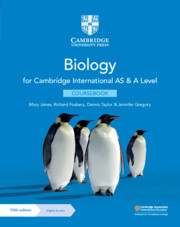
This book meets the needs of students for mastering biology at both beginner and advanced levels, suitable for international exams such as the IMAT exam and BMAT exam . Cambridge authors developed this book with extensive research, teacher interviews, and collaboration with the research community. Exam-style questions help students build confidence.
- Summaries and creative boxes to teach metacognitive and reflective opportunities based on the taught material
- Features Science in Context with open-ended discussion questions to strengthen English skills and interpret ideas in the real world
- Multi-part exam-style questions at the end of each chapter that help prepare students for exams
- Covering a wide range of exam questions such as practical activities, group work and discussion questions
- Includes explanatory answers to all in-season and exam questions so that students can focus on their weaknesses.
- Asking the student for a practical activity that improves their understanding of the subject and introduces them to the real-world application of the lessons.
2.Cambridge Biology for IB Diploma:
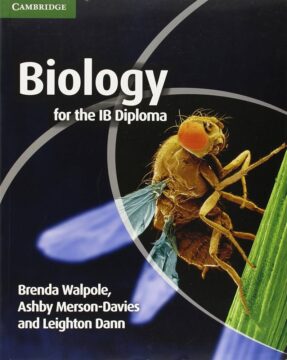
Biology has developed at a rapid pace in recent decades and has truly become a science of the 21st century. Advances in genetics, biochemistry, medicine and cell biology have kept this field at the forefront of international news. Cambridge Biology for ib diploma is the most important resource for the IMAT exam, which offers teaching and learning based on the most up-to-date scientific findings and in a conceptual way, considering these extensive developments. There are numerous questions throughout the book that engage the student. This teaching aid book, written by experienced IB Diploma teachers, is fully compatible with the new International Diploma Biology curriculum. This resource is written by experienced IB Diploma teachers and aligns with the latest biology curriculum, covering practical work, theories, and new topics comprehensively.
- Strengthening the skills and techniques needed by the student to answer questions and solve problems
- Teaching the basis of practical work
- The possibility of self-assessment
- A wide range of engaging activities with real-world practical examples
- Provide extensive training for students who want to become future doctors
3.CGP A-LEVEL Biology: AQA:
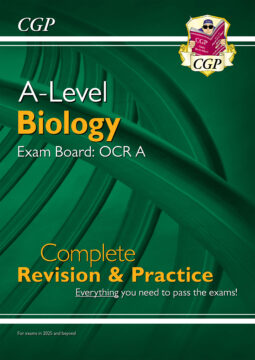
It provides comprehensive review and practice for high school students and is fully up-to-date with the latest changes to the A Level Biology syllabus. This educational aid book can be used to strengthen the basic skills in the biology lesson, and its simple textbook, useful examples, and full-color diagrams can be used to master the important and basic concepts of this lesson.
In addition to the detailed explanations of each topic, this educational aid book includes the following educational materials:
- Lots of practice questions and exam-style questions (with descriptive answers)
- A combination of different sections for the course of lessons learned
- A section containing practical advice to strengthen practical skills
- QR code to access the free online version
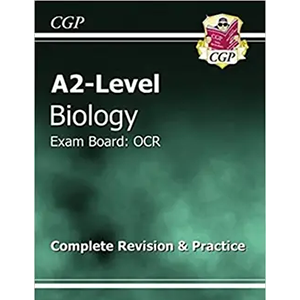
The most important resource is the IMAT exam, which is completely compiled with the latest changes in the A2 level biology course topics and is an excellent study aid resource for passing international exams that pave the way for you to study at the best universities in the world.
Each chapter of this book has very simple and practical explanations with useful examples and full-color diagrams that help you better understand the biology lesson.
With lots of practice questions and exam-style questions (with explanatory answers) along with a section that includes a combination exercise to review what you’ve learned, you have access to all the material you need to strengthen your biology foundation.
- Clear and concise review and practice ideal for preparing for A2 level biology exams
- Simple explanations, useful examples and full color diagrams
- Practice questions and exam-style questions (with answers) for each topic
- Practical guide on practical skills
- Code printed inside the book to access more exercises on PC, Mac
Essential Tips for Success in the IMAT Biology Section
For you, as an IMAT test applicant, mastering the biology section is a basic principle for success. In the following, we have provided some tips for your success:
1.Understanding the IMAT Biology Syllabus
In your biology curriculum, you should start with more key topics, examine different types of biology questions and do not neglect the fundamental concepts in the fields of genetics, biology, physiology and ecology.
2.Using authentic books in the field of IMAT biology
Above, some reliable sources and textbooks for IMAT exam revision were introduced to you In addition Try to use the resources that are specifically designed for the IMAT exam Moreover include practice questions.
3. Review of previous years’ IMAT exams
One of the ways to succeed in the IMAT exam is to analyze and solve the IMAT exams of the past years, which in addition to reviewing the information and familiarizing yourself with the style of the questions, will also help you in time management.
4.Focus on conceptual understanding
Considering that a group of questions asked in the exam are conceptual questions, then as an applicant, you must be diligent in understanding the basic concepts and contents of the biology courses so that you can understand the relationship between the contents well in addition to the correct analysis of the questions.
5.Mastery of biology terms
In addition to the conceptual questions in the biology section of the IMAT exam, there are also questions in the form of defining terms. try Learn the key terms of biology and be familiar with their definitions. It is highly recommended to use memory flash cards.
6.Active learning
One of the helpful things is the use of active learning techniques, such as summarizing or teaching the read material. This method helps you better understand and remember the material.
7.IMAT Mock Exams
Simulated mock tests help you to know your weaknesses in addition to practicing time management for the exam session and help you to have a coherent plan in the final summaries.
The comprehensive online IMAT course includes mock exams and preparation sessions to enhance candidates’ performance. These courses provide practical exercises and simulate exam conditions to help candidates prepare effectively and achieve high scores. The preparation courses are divided into comprehensive and intensive formats. Candidates with more than six months of preparation time typically enroll in the comprehensive course, while those with shorter time frames usually opt for the intensive course if they plan to take the exam in September of the same year.
conclusion
By registering for IMAT courses on the Course In Use website, you can benefit from specialized classes with international standards and outstanding instructors In addition to these courses, review and testing strategies are also included. So, take your first step right now to accept Italian medicine in the best Italian universities
FAQs
1.How many biology questions are in IMAT?
- Twenty-three biology questions.
2.What is the summary of IMAT biology?
- The biology section of the IMAT exam consists of various topics such as types of tissues and organs, cellular processes, cells and their structure and function, cellular respiration and photosynthesis, and in general, the main topics of biology.
3.What are the major topics in biology?
- biochemistry
- Cell Biology
- Diffusion and osmosis.
- Microbiology (Viruses, Bacteria, Fungi)
- Evolution and Ecology
- Molecular biology
- Genetics
- Human Anatomy and Physiology
4.What is the difficulty level of the IMAT Biology questions?
- In general, the biology questions in the IMAT exam have a suitable level, in other words, the questions do not vary from simple to difficult, but in general, the level of the IMAT questions is considered average and is based on high school biology, but in between, some complex questions are also asked. For example, molecular biology and genetics are discussed in more detail. Be more careful in reading these materials
5.How do you memorize and study biology?
- Read and understand the content conceptually
- If you use preparatory classes, review the material before the class
- Memorize the definitions for this you can use flashcards
- Have active learning by summarizing
- Use training courses suitable for your level
- Have a regular study schedule
- Don’t forget the daily review material and practice tests to avoid forgetting

